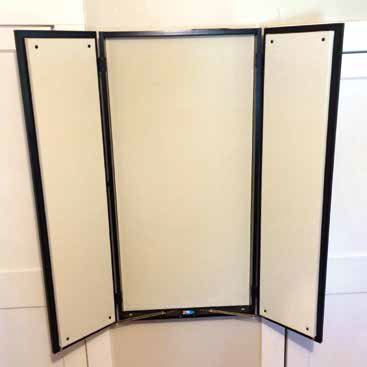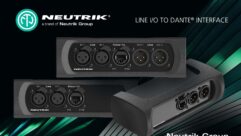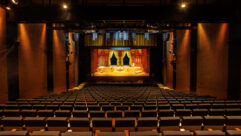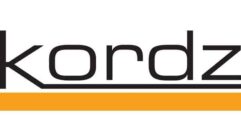

Primarily vocal capture tools, Primacoustic’s flexible absorptive and noise attenuating products are affordable and quite useful in multipurpose A/V production environments.
I’ve long found Primacoustic—the acoustic materials firm birthed from Canada’s respected Radial Engineering—to be a rich source of absorptive materials for improving the many lackluster environments we must often use in audio capture. Not only are they attractive, fire resistant, and well made, they boast well-chosen sound absorption characteristics for most residential, commercial, and institutional (read: non-acoustically designed) spaces. In other words, Primacoustic “gets it.” Below, I detail two unique and affordable products that may help solve some of the common acoustics issues you, or your clients, most often face.
Primacoustic’s FlexiBooth ($449 street) is an absorptive vocal booth in “cupboard” form from the company’s Broadway acoustic panel series. It is designed to hang on the wall of your audio workspace. Closed, its casing—made of black melamine-coated MDF (medium-density fiberboard)—measures 2ft. wide, 4ft. high, and a bit over 5in. deep. With both 4x1ft. doors open, the FlexiBooth becomes a 16-cubic foot VO (voice over) environment.
Several years ago, I reviewed Primacoustic’s Broadway Series of acoustic products during a complete refurbishment of my primary audio workspace. It was a major improvement overall, both in monitoring accuracy and overall sound. Naturally, when presented with the opportunity to review the FlexiBooth, primarily comprised of the same high-quality absorptive materials as the Broadway Series, I was intrigued. While it is primarily marketed as a wall-mounted vocal booth, its potential uses are anywhere from conventional to literally “off the wall.”
FlexiBooth’s absorptive components are high-density (6lbs. per cubic foot) encapsulated fiberglass panels with resin-treated panel edges, covered with acoustically transparent polyester fabric in black, gray, or beige (which can even be covered with a second fabric to better match or to develop a unique décor, if desired by the user). Three panels—two 46in.x9.75in.x1in. on each door and one 46.75in.x22.5in.x2in. in the middle—provide the absorptive zone of an open FlexiBooth. [Detailed absorption characteristics of FlexiBooth are available on the Primacoustic website at www.primacoustic.com/flexibooth-specs.htm—Ed.]
Completely unconstructed, the FlexiBooth comes with numerous parts: the three panels, seven MDF pieces, and several bags full of cam locks, wooden dowels, screws, pins, dry wall anchors, etc. Also enclosed are two door guides, four door hinges, and two magnetic door catches. Last but not least, accurate and well-illustrated assembly instructions are included and feature both diagrams and photos.
Of course, before I could place the FlexiBooth in use, I had to build it. With basic tools (Phillips head and flathead screwdrivers, small hammer, power drill, and level) and an extra set of hands, the Flexi-Booth was together and hung in place with well under two hours of labor invested, even working at a relaxed pace.
Once constructed, I screwed the FlexiBooth’s mount, a French cleat, on the rear wall of a small editing/control room (with tie lines to other recording spaces). This environment is much like general A/V rooms in many houses of worship (HOWs), corporate spaces, etc., where audio content may be captured, produced, and distributed. In this position, placed between an entrance door and closet door, the FlexiBooth (when open) would double as an adjustable absorptive surface behind the mix position and a VO space, maximizing the functionality of this small production room. In both applications, FlexiBooth excelled.
Since FlexiBooth can be easily lifted off the beveled edge of its wall cleat, I also auditioned it as a “gobo” in front of acoustic instruments, amplifiers, drum kits, etc. The back of the FlexiBooth exposes most of the rear of its nearly 2ft.x4ft. Broadway panel, so additional absorption was gained in any “off the wall” application. It’s also worth noting that, when closed, the FlexiBooth becomes a hard, reflective surface. The idea of several FlexiBooths mounted around a room in varied positions of open, closed, and somewhere in between would allow lots of sonic options; this could be particularly appealing in “cold-sounding” commercial buildings/office spaces full of sheet rock, drop ceiling, and carpet over concrete floors—quite often the environment for modern HOWs, etc.
As the name implies, FlexiBooth is indeed very flexible, thus making it much more than just an acoustic product for tracking vocals. It’s attractive, clever, useful, and much more than the sum of its parts.

Primacoustic’s latest incarnation of its VoxGuard, the Primacoustic, features a clever Plexiglas window embedded within its proven nearfield vocal screen design.
Primacoustic’s VoxGuard VU ($99 street) is a microphone-surrounding ambient noise attenuator from the company’s IsoTools acoustic accessories series. It is comprised of a durable polypropylene shell with eight strategically-placed slit openings; scalloped, hard foam core absorptive material on its “performance” side; and a 3in.x7in. Plexiglas window, better enabling vocal cues and group tracking collaboration. The VoxGuard VU mounts directly to any standard microphone stand; it can be used with a side address studio microphone, a front address microphone, and a studio mic with large boom extension.
In use, I was impressed by the VoxGuard VU’s effectiveness. Most notably, it excelled in ensemble applications, where a vocalist may be captured via microphone while surrounded by other instruments; while it couldn’t isolate the preferred sound source, it did significantly reduce bleed from other sources, ultimately allowing the signal to be cleaner, more direct, and a useful bit less reverberant. The “VU” aspect of Primacoustic’s VoxGuard upgrade is significant; I can’t imagine using it without the window after having access to the VU model, especially for vocal capture applications.
I also applied the VoxGuard VU in non-musical applications, recording spoken word and phone tree messages in the kind of cinderblock-walled room often found in commercial and institutional environments. Using a large diaphragm condenser with a tight cardioid pattern, the “VoxGuarded” recordings were far more usable and “more professional” sounding than those captured without, for direct comparison. I’d recommend a VoxGuard for HOWs, schools, and other applications to reduce springy “bad room” reverberation in daily announcements, for just one example; at less than $100, it’s worth the cost as it would likely find uses in other institutional A/V applications, too.
Strother Bullins is NewBay Media’s reviews editor, AV/Pro Audio Group, active musician, recordist, and club-level sound reinforcement wrangler. [email protected]
PRODUCT SUMMARY
COMPANY: Primacoustic
www.primacoustic.com
PRODUCT: Primacoustic FlexiBooth, Broadway Acoustic Panel Series
PROS: Well-made panels, components, and parts; fire-resistant; easily assembled; flexible/multipurpose; easily removed from its wall mounts for portability
CONS: Heavy (only applicable in “off the wall” use)
APPLICATIONS: Studio/recording, HOW and institutional/internal-use media production, pro-project/home recording.
PRICE: $449 each, street
PRODUCT: Primacoustic VoxGuard VU, IsoTools Acoustic Accessories Series
PROS: Lightweight and super-portable; fire-resistant; flexible/multipurpose.
CONS: Noise attenuation capability is limited
APPLICATIONS: Studio/recording, HOW and institutional/internal-use media production, pro-project/home recording.
PRICE: $99 each, street










